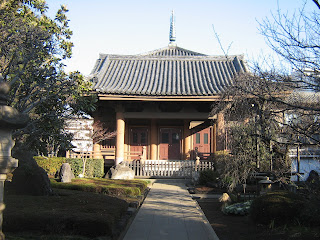On January 9th I went to Shiinamachi 椎名町 to visit the Kongō-in 金剛院and the adjacent Nagasaki-jinja長崎神社. The Kongō-in, which is dedicated to Amida-nyorai 阿弥陀如来 and his servants Kannon-bosatsu 観音菩薩 and Seishi-bosatsu 勢至菩薩, was founded in the 16th century by the monk Shōben 聖弁 from the Shingon Buzan sect (真言宗豊山派 Shingon-shū Buzan-ha).
In front the temple grounds there was a small shrine that holds a statue of the Nagasaki Fudō-son 長崎不動尊. The bright colours of the curtains and the flowers certainly give this shrine a South-Asian esoteric touch, but other elements, like the Sanbō 三方 on which fruit is presented to the deity or the Shintō style o-mizya お水舎turn it into a typically Japanese sanctuary.
The Kongō-in used to be known as the Akamon-dera 赤門寺 because of its distinctive red gate that dates from the late 18th century.

On the temple grounds as well one can find several South-Asian elements that give away the temple’s esoteric affiliation, like the Siddhaṃ writings on the bamboo sticks seen at the graveyard. The o-mizuya gives proof of the early Japanese Buddhist schools’ (mainly Shingon and Tendai-shū 天台宗) willingness to assimilate with local beliefs.
All over the temple grounds (but also on the shrine grounds of the Nagasaki-jinja) there were dozens of cabbage-like vegetables, which turned out to be habotan 葉牡丹 when I inquired about it to some visitors and maintenance people. Some figures made out of straw were placed next to them, but no one I asked (including teachers at my university) could tell me the meaning of these mysterious dolls. I was told, however, that the straw mats that are tied around the trees are meant to lure the bugs trying to get through winter. When the bugs are about to wake up and leave their winter residence when it starts to get warmer the mats are burned ritually to protect the harvest (虫送り Mushi-okuri?). It seems likely that the dolls made out of straw have a similar meaning.
Over the graveyard watches an impressive Shō Kannon-bosatsu standing on a rather modern looking construction, with even more modern looking vases and a peculiarly shaped incense burner in the middle which is fashioned to prevent rain from getting in.
Right across the Kannon-statue were some Jizō-bosatu 地蔵菩薩 statues adorned with red bibs. The combination of Kannon with the red-bibbed Jizō may indicate Mizuko kuyō 水子供養.
To be continued.












Geen opmerkingen:
Een reactie posten